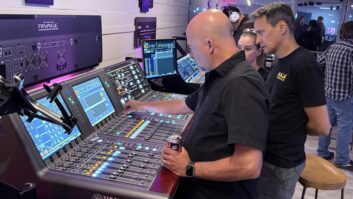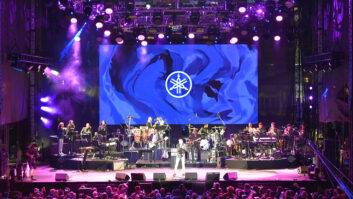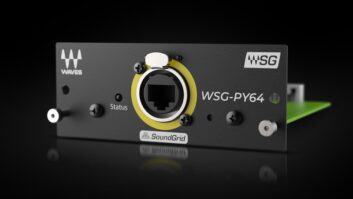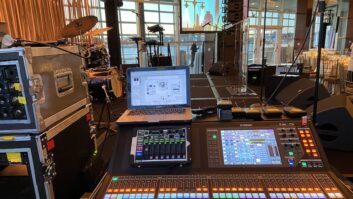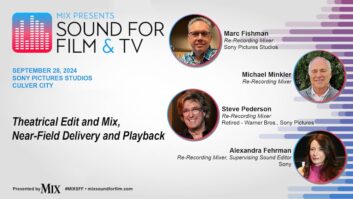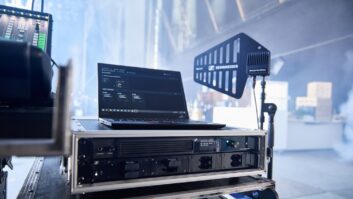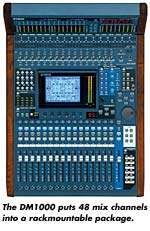
Ten years ago, there were no digital mixers in the 5-figure range,
but that changed with the introduction of Yamaha’s 02R. This product’s
lineage has been tremendously successful and continues to be so. Today,
Yamaha’s DM2000 flagship digital studio mixer — at a retail price
of $18,300 — is a mighty competitor for other products in the
same price range.
This field test focuses on the DM1000, which at $5,299 (base),
sports a feature set that’s only a little less impressive than its
larger counterpart. The DM2000 allows 96 channels at mixdown, whereas
the DM1000 allows 48, certainly enough for many users and scenarios.
The DM2000 sports 30 buses, compared to 18 in the smaller unit; four of
those are stereo matrix buses, a feature that the DM1000 lacks. Both
consoles include effects DSP: the DM2000 with eight units and the
DM1000 with four. The DM2000 has 12 auxes compared with eight in the
DM1000, and the DM2000 has six graphic EQs, while the DM1000 has
none.
LAYOUT AND ERGONOMICS
The 02R96 and DM1000 share many similar features, but the 02R96 is
intended mainly for broadcast or production, while the DM Series is
equally at home mixing a concert as it is mixing a film in surround,
and, of course, it is fully capable of stereo music or broadcast
production. There are other consoles with deeper features for specific
applications, but for a console that can handle virtually any task, the
DM1000 represents a significant value considering its price. For live
sound applications, the DM1000 is particularly nice, as the
user-friendly and easily accessible functions aren’t always found in
other digital consoles. There’s no racing through menus to get to the
function you need: A couple of button presses, and you’re there.
Although it’s not tiny, the DM1000 is rackmountable, a surprising
feature for such a powerful console.
This console’s control surface is elegant from an ergonomic and
operational standpoint. The wood panels make the console nice-looking,
the layout of controls is truly eye-catching and the control layout
makes sense. Indeed, there are only a handful of controls that require
the user to open the manual.
One clever control surface feature is the use of diamond-shaped
buttons that change the mode of operation and, correspondingly, the
display. To the left of the main LCD screen is a bank of such buttons,
and there are also a few scattered about the surface. Touch one of
them, and you are immediately taken to the corresponding page and the
data-entry controls are enabled for that function. Although many of the
display’s “pages” have a handful of “tabs” at
the bottom, I didn’t have to engage in much menu-diving to get to where
I wanted. In fact, most of the tabs are used to toggle between channel
banks, so Yamaha didn’t have to squeeze graphical displays that
represent all 48 channels on a single page.
I recorded vocal overdubs and mixed the final product on my first
DM1000 project. I had not used the console prior to this project, so I
forewarned my client, fully expecting to grant a lot of comp time or
simply not charge for the sessions. My client and I were both
pleasantly surprised at how smoothly the sessions went.
I quickly — and easily — set up equalization, dynamics
and aux sends on any channel. The diamond-shaped buttons took me to the
main page, I cursored using the up/down/left/right buttons and then
adjusted parameters with the data-entry wheel. The EQ was particularly
intuitive: I simply selected a channel, moved to the “selected
channel” section and tweaked the knobs as you would on an analog
console. Old-school engineers who gravitate away from digital consoles,
have no fear: You will soon feel right at home with the DM1000.
Each channel has a rotary encoder that can be set to panning, auxes
or other parameters. There are also Select, Solo and On buttons for
each channel. The 100mm motorized faders are silky-smooth, a far cry
from the herky-jerky plastic faders on my old ProMix 01. Another nice
feature is the bank of user-defined keys that can be assigned to do
almost anything.
PC CONTROL WITH STUDIO MANAGER
Although the joystick for surround positioning is small, it’s a
welcome addition when surround mixing. In general, the surface is
clearly and thoughtfully laid out, and the LCD screen is clear and
easily read. It’s nice to have a graphical representation of panning
information in surround. A particularly pleasant surprise is the
console’s ability to display surround-panning information for each of
the 16 channels per page.
Another nice feature is Yamaha’s Studio Manager software. Via USB
connection to a host computer, it allows control of virtually every
mixer parameter from your computer. The software displays the entire
console (as a virtual analog board) or each channel individually. You
can edit the parameters of the effects processors, surround panning and
internal connections, rendering the mixer a powerful “virtual
patchbay.” Additionally, a single computer can address multiple
Yamaha consoles. Libraries and scenes can also be stored to the
computer, making the console tremendously powerful. There are also
MIDI, Word Clock, 9-pin video and 25-pin GPI connections to communicate
with other devices. The SMPTE input is a pro XLR connector. With the
computer’s enhanced display capabilities, the software makes console
operation even easier than with the console’s own controls.
COMPREHENSIVE AND FLEXIBLE I/O
The Layer buttons determine which bank of 16 mixer channels is being
controlled; more importantly, two layers of remote DAW control are
available. During mixing, you can quickly navigate back between
controlling audio that is passing through the console and control of
Pro Tools, Nuendo and other DAWs that emulate the Pro Tools control
protocol. I experimented a bit with Pro Tools, playing initially with
level, panning and so forth. Ultimately, though, I discovered that the
DM1000 also controls auxes, solo, mute, channel flip and other
features. One truly powerful feature is Pro Tools scrub/shuttle control
that uses the DM1000’s data wheel. The console’s display also reflects
Pro Tool’s time code. Console-to-computer communication is handled via
USB, which is eminently faster than MIDI.
The DM1000 also sports Automix, a sophisticated internal automation
system. It offers automation of the usual channel levels, mutes and
panning, but also adds automation of surround panning, EQ, auxiliary
levels and mutes, scene recalls, library recalls for EQ, gates,
compressors, effects and channels. Certain effects parameters can be
automated, as well. A powerful Automix feature is the ability to
automate user-defined remote layers (for instance, level, panning,
etc.) of your DAW. You don’t actually have to pass signal from your DAW
through the console in order to have control over it; automation of the
entire mix is handled from one location.
SHOULD I HAVE ONE?
The I/O available on the DM1000 is comprehensive. There are 16
mic/line inputs (with phantom power-switchable per channel) and four
line-level-only inputs. Yamaha has chosen wisely to refer to the analog
outputs as “Omni Outs,” sidestepping the notion that each
is locked into an exclusive purpose. These outputs can be configured to
user preferences as stereo, bus or monitor outs, and, most importantly,
input channel direct outs, which allows multichannel
tracking/overdubbing or analog-domain insertion of dynamics processing.
The stock digital I/O is nothing to write home about, with two AES/EBU
and two S/PDIF co-ax ports intended for 2-track I/O. However, the two
mini-YGDAI card slots accommodate various cards with other I/O options,
such as AES/EBU, TDIF, ADAT or TOSlink Lightpipe, and even FireWire.
Waves’ Y56K card with DSP is also supported. The unit that I worked
with was fitted with the ADAT Lightpipe card, allowing signal flow
through my MOTU 828 interface.
Internally, Yamaha’s DM Series consoles provide 24-bit/96kHz
resolution, like many other digital mixers. However, with many other
consoles, 48 kHz is the default, and 96kHz operation cuts the DSP and
I/O in half. With the DM1000, nothing is lost. All functions are
available at 96 kHz, and at such a high resolution, most of the
complaints that typically hover above digital audio have nowhere to
land. The A/D converters associated with the DM1000’s analog inputs are
linear 24-bit, 128x oversampling units that operate at 44.1/48/88.2/96
kHz. Yamaha’s philosophy on D/A conversion reflects the notion that if
you deliberately choose top-notch mic pre’s, A/Ds and internal
processing, then the D/A conversion should be equally good. With that
in mind, the DM1000 uses the same high-quality D/A’s as the DM2000.
Included on my digital console “want” list are
operations to make it feel like a simple analog console. I need
flexible signal routing: My studio requires that the console also
serves as a virtual patchbay. I want high-quality audio, especially
with EQ, dynamics and reverbs. I want sophisticated control over my
DAWs, not just moving fader-level control. I also require lots of I/O,
both analog and digital.
Here’s how the DM1000 stacks up. In terms of ease of operation, this
console is intuitive and feels comfortable. Other than digital features
not having a counterpart in the analog domain, the control surface
feels plenty traditional. Regarding my virtual patchbay requirement,
the DM1000 not only enables routing of nearly any input to nearly any
output, but it also enables library storage of any routing scheme,
either internally or via computer.
The converters and EQs sound great, and the dynamics processing is
much better than you’d expect in the digital domain. The history of
onboard DSPs reflects the development of rackmount processors also made
by Yamaha. For instance, the venerable ProMix01 had many of the same
presets and the same quality level represented in the classic SPX90.
More recent upgrades with products like the SPX990 raised the bar, and
now the DM1000 and DM2000 share many presets and the quality level
featured in the SPX2000, Yamaha’s latest outboard DSP. All internal DSP
happens at 32-bit resolution, a step up from the 24-bit resolution of
prior products. I used the reverbs on vocals, and they were smashing.
Dynamics processing also sounds more natural than what people are
accustomed to in the digital domain.
Implementing DAW control is impressive, but the only area that
disappointed me was the I/O. The amount of analog I/O is adequate, but
if you need a lot of digital I/O, you’ll end up spending more money.
It’s understood that Yamaha wishes users to customize the digital I/O
to their own needs, but some formats are so universal that they should
be automatically presented without any additional purchases;
specifically, ADAT Lightpipe and TDIF.
I was able to compare it to a competing (and, in fairness,
less-expensive) product that already existed in my studio, and I
reached the conclusion that I would unequivocally prefer the DM1000. I
love the way it looks, sounds and how it operates. The DM1000 towers
over other digital mixers in its class and price range.
Yamaha Professional Audio, 714/522-9011, www.yamaha.com/proaudio.
John McJunkin is the principal of Avalon Audio Services
(Phoenix).

